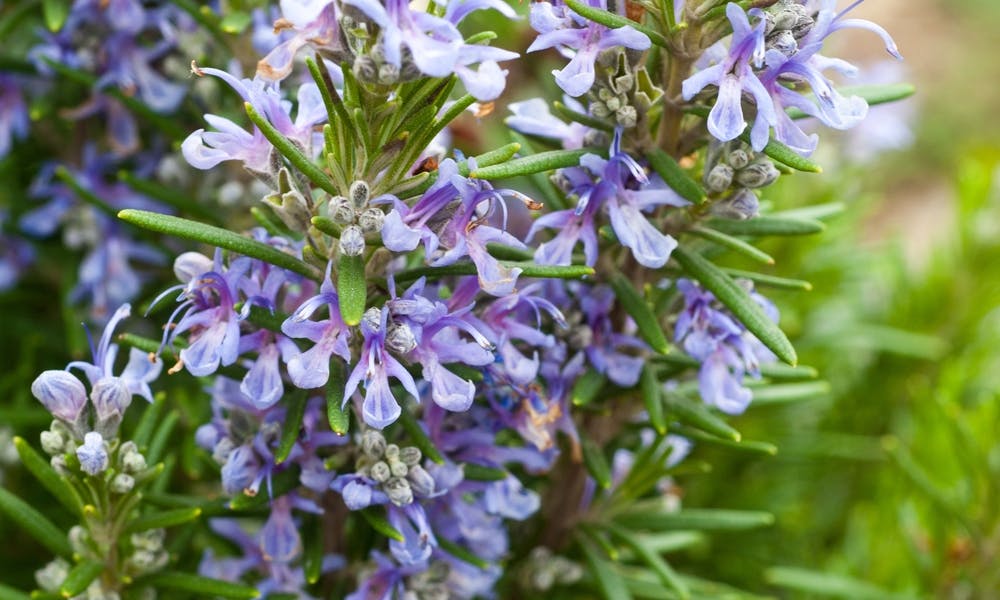The wonderful rosemary (Rosmarinus officinalis) is a Mediterranean shrub, famous for its beauty and its uses in gastronomy due to its delicious, aromatic and slightly bitter taste. Furthermore, the rosemary plant has multiple uses in the cosmetics and perfume industry. Read on to find out more information about:
* What is the rosemary flower?
* Varieties of rosemary flower
* How to grow and care for rosemary flower
* Rosemary flower – origins, history, customs
* Rosemary flower – uses
What Is the Rosemary Flower?
Rosemary is part of the Salvia genus and belongs to the Lamiaceae family that also includes other medicinal plants. It is a perennial shrub with short, needle-like leaves, dark green and glossy on the surface. The seeds have a low germination level; thus, the plant grows relatively slowly, reaching up to a maximum of 6 feet high, and can live up to 30 years.
Rosemary blooms from middle spring to end of summer in temperate areas but you can see rosemary blooming from mid-February to early December in the Northern Hemisphere. Its flowers are white, pink, purple or dark blue.
Varieties of Rosemary Flower
There are many varieties of rosemary. We mention here only a few of them:
* Rosemary golden rain is a unique variety that has bright yellow foliage, the leaves darkening in color as the plant matures; furthermore, beautiful blue flowers are typical to this rosemary variety.
* Rosemary pink-flowered Majorca is a tall, upright plant with beautiful flowers and a slightly fruity scent. It is a very fragile species and needs protection against frost.
* Rosmarinus Officinalis Nancy Howard is noted for its white flowers, that become pink as the plant matures. The leaves of dark green contrast with the stiff and white stalk in a very pleasant way.
* Rosmarinus Officinalis Haifa is extremely strong, produces flowers of a pale blue and its branches are as green as the foliage. It is widely known as the culinary plant.
How to Grow and Care for Rosemary Flower
Because it is attractive and drought resistant, rosemary is used as an ornamental plant in regions with a Mediterranean climate. The soil should be peat or part peat and part sand, which can provide adequate drainage. Rosemary does not withstand frost.
Multiplication of rosemary is done by sowing seeds in March or April or through cuttings from semi-logs. The cuttings should be planted eight to 10 weeks before the last spring frost. It may take longer for the seeds to germinate, so should not give up immediately and the soil should be well-drained and with a temperature around 70o F.
Another method of multiplication is marking. In June, you need to make sure that the base of the stems is covered in ground moss. In autumn, the rooted stems are separated by horticultural shears into several rosemary plants.
Throughout the growing season, the plant should be watered evenly and not excessively. In winter, put the plant in a pot and keep it indoors to protect it from freezing temperatures. After the plant flowers, do not forget to cut the plant and you should be careful to get cuttings or divide the plant for the next season. This is especially relevant if the temperature drops dramatically during the winter.
Rosemary Flower – Origins, History, Customs
Rosemary is a shrub of Mediterranean origin, a perennial plant that grows spontaneously on the seafront. Its name comes from the Latin language where “Rosmarinus” means sea dew or from the Greek language, where it means aromatic plant. It is an ornamental, aromatic, and medicinal plant.
Rosemary is one of those plants with a thousand uses and resembles mint and lavender. This plant from the Mediterranean area is very popular in gastronomy either fresh or dried, offering a wide range of nutritional benefits. The list of vitamins and minerals contained by rosemary is very large. Due to the unique compounds contained in the essential oils, namely camphor, borneol acetate, rosemary improves memory and helps fight against cancer.
Rosemary was considered a sacred plant by the ancient Egyptians, Greeks, and Romans. The plant was used at commemoration ceremonies and was considered as a symbol of remembrance and friendship.
The first mention of rosemary is known from the tablets of cuneiform stone from 5000 BC. The Egyptians used it in their burial ceremonies. Pliny the Elder wrote about this formidable plant in his book entitled “The National History.” In America, the rosemary arrived with the European colonists of the 17th century.
Rosemary Flower – Uses
The flower buds are used in the fresh state to obtain the etheric oil used in the perfume, cosmetics and food industries. They are harvested during the flowering phase starting with the third year of cultivation.
The powder obtained from grinding the rosemary flower or the solution obtained by cold maceration or infusion leads to stimulation of the cerebral and peripheral circulation, memory improvement, increasing of mental tone, increasing digestive capacity.
Rosemary provides Vitamin A and also contains iron and potassium. Vitamin A plays a crucial role in vision and the immune system, while iron carries the oxygen in the bloodstream. Finally, potassium maintains the proper functioning of the muscles and might help reduce blood pressure.
Rosemary is also extensively used for its antispastic, diuretic, antiseptic, and antifungal effects. It has also been demonstrated that rosemary has an antioxidant effect, prevents obesity, and hypertension. Externally applied, rosemary has an antirheumatic effect and helps to heal skin conditions, including eczema, bruises, or open wounds.
All in all, besides the beauty of the shrub and flowers, rosemary has multiple uses both in many recipes and to treat different conditions. Whether you use it for the beauty of the rosemary flower or its delicious addition to many recipes, rosemary flower is certainly a champion among others.
